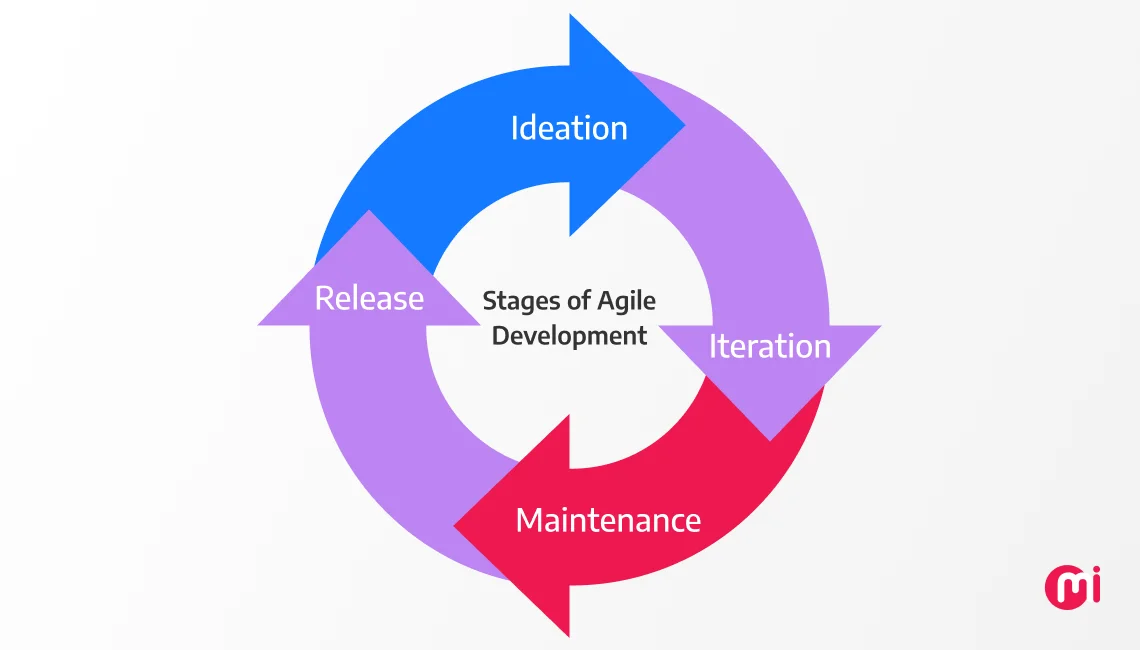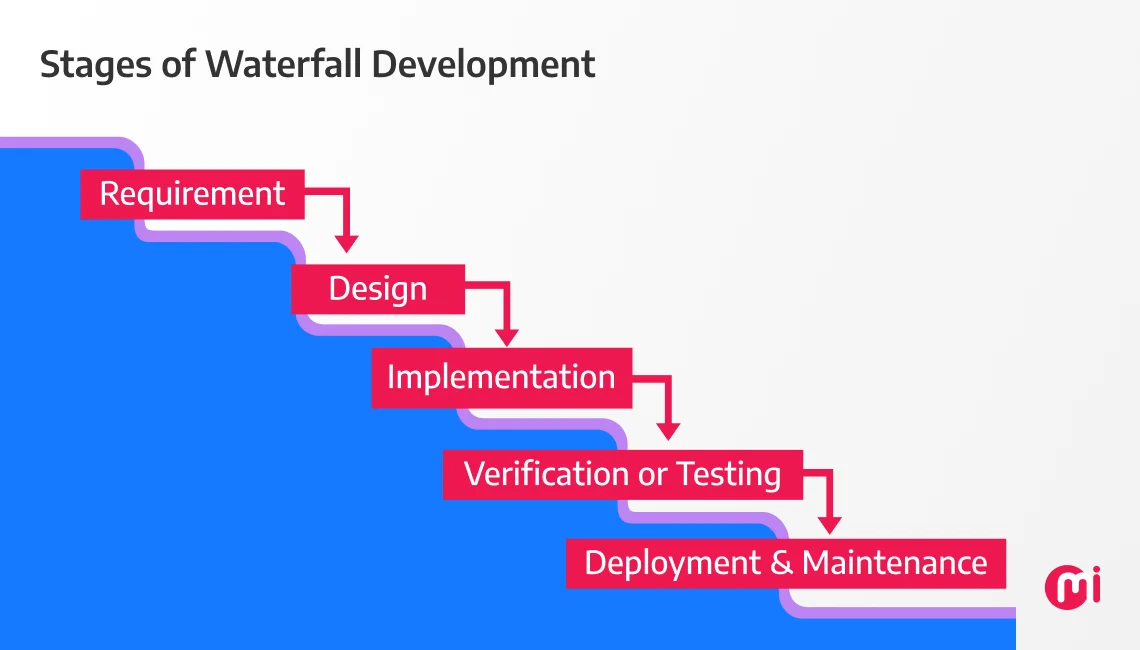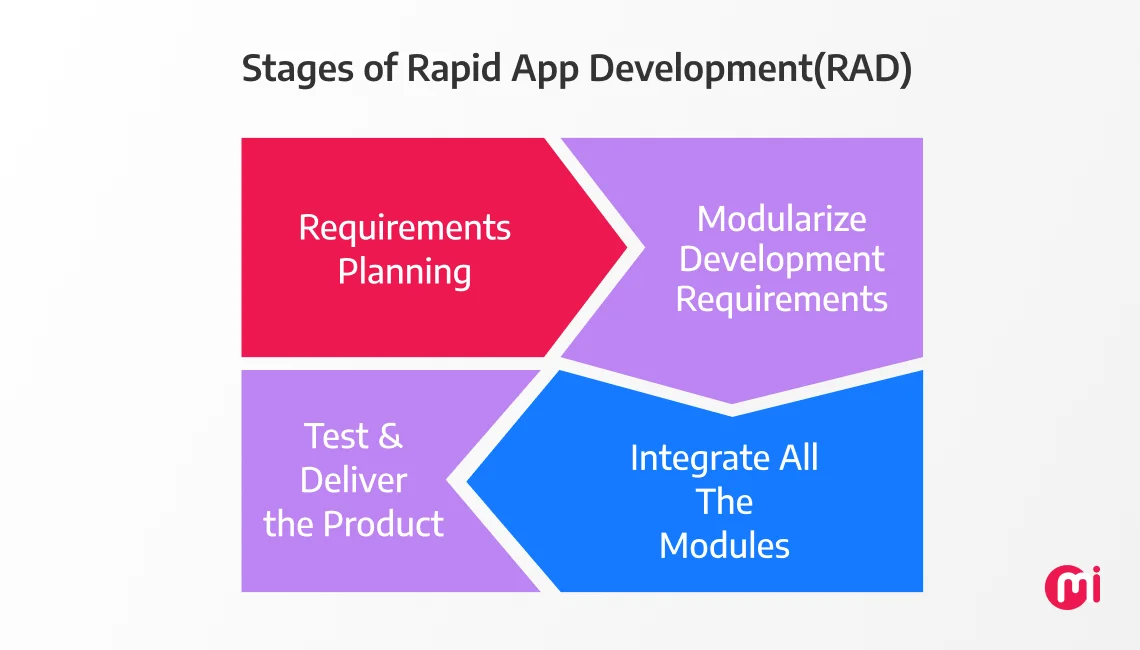5 Software Development Methodologies: Which One is Right for You?
- Software
- October 21, 2024
Developing software and wondering which development methodology best suits your project? With so many options of software development methodologies available, the decision can feel overwhelming. In this blog, we’ve mentioned modern software development methodologies, including Agile, Waterfall, Lean, RAD, and DevOps, to help you choose the right one for your project.
Do you know what’s the most disappointing thing in the IT world? It’s a software development project suffering from delays or budget overruns. A survey conducted by BCG, revealed that more than 30% of technology development projects get late to delivery and often go out of budget!
What You Need to Know About Software Development Methodologies
Software development methodology is a set of 3Ps – principles, practices, and processes that help you deliver a product within your desired timeline and budget. Each methodology offers a unique approach to managing tasks, resources, and project stages, ensuring the final product aligns with your vision.
The right selection directly influences how efficiently your team works and how adaptable your project is to change. Whether you’re focused on rapid delivery, customer feedback, or risk management, the right software development method aligns with your specific business priorities.

Top 5 Types of Software Development Methodologies You Can Choose For Your Project
You’ll find multiple software development methodologies available for your project. However, in today’s rapidly evolving digital landscape, only a few methodologies are capable of meeting the demands of frequently changing requirements. Some of the most popular software development methodologies today include.

1. Agile
Agile methodology is a software development methodology that breaks down a software development project into multiple sprints, each backed by design, development, test, deployment, and review & feedback loop. Its multiple sprints option gives freedom to developers and businesses to experiment by raising change requests at any stage without making processes complex.
Best For:
- Where multiple change requests are expected frequently.
- Teams that value customer feedback and adaptability.
- Complex, large-scale software projects where iterative progress is beneficial.

Stages of Agile Software Development:
- Ideation – Requirements are documented, tasks prioritized, and resources allocated by keeping stakeholders and considering users in the loop.
- Iteration – Projects are executed in multiple sprints, with each sprint contributing to the progression of the product
- Release – The software product is released after the execution of multiple sprints and iterations.
- Maintenance – Continuous support and updates post-launch.
Pros of Agile Software Development Methodology:
- Highly adaptable to changing requirements
- Satisfies customers through continuous and up-to-date software delivery.
- Delivers functional software in shorter cycles.
- Encourages active communication and collaboration of business people and developers.
- Promotes sustainable development
Cons of Agile Software Development Methodology:
- Calculating the project delivery timeline is difficult as it may have to handle frequent change requests during development.
- Development teams may face burnout as they have intensive requirements for communication and collaboration.
- It may burden the team while asking for more time and commitment for communication and collaboration.
- Documenting each implementation thoroughly might not be possible as there are frequent changes.
- Tracking projects can be a burden.
When using Agile methodology, you can also use its framework SCRUM to create fixed-length sprints of short iterations (usually for 2-4 weeks with fixed scope) for enhanced team management and progress tracking. Do you know how beneficial is Agile methodology for mobile app development, read to know more.
Unlock the power of Agile software development to enhance your workflow. Learn about the Agile Manifesto’s principles, explore top methodologies, and discover the proven benefits.
2. Waterfall
Waterfall software development methodology is a linear, sequential software development process where each phase must be completed before the next begins. It follows a strict flow of steps, with little room for changes once a phase is finished.
Best For:
- Projects with well-defined, stable software development requirements.
- Software projects that require detailed upfront planning and formal approval.
- Situations where strict documentation is required.

Stages of Waterfall Software Development Methodology:
- Requirement – All project requirements are gathered and documented.
- Design – A detailed software architecture and system design is created.
- Implementation – The actual coding and development of the software are executed.
- Verification or Testing – The developed software is tested to ensure it meets the required specifications.
- Deployment & Maintenance – The software is deployed to the production environment and maintained and updated as needed.
Pros of Waterfall Methodology:
- Design errors can be discovered earlier before development
- Project development costs can be accurately calculated
- Project progress becomes easy and transparent
- Your project can be put on automation as requirements and implementation plans are well-documented
- No delay in the project delivery as it’s strictly scoped
Cons of Waterfall Methodology:
- The chronological approach may make it slower to deliver the project
- Opening and catering to the change request in the later stage of the lifecycle may create complexities in execution
- Customers only see the product at the end of the process, which can lead to misalignment with expectations.
- Problems detected late in the process can be costly and time-consuming to fix.
Did you know? There’s a huge battle between Waterfall Vs. Scrum? Read the linked blog to know which software development methodology wins the game.
3. Lean Software Development Methodology
Lean Software Development shares the values of the Agile methodology in terms of adaptability and collaboration but focuses more on eliminating waste, building for quality, creating knowledge, deferring commitment, respecting customers, and delivering the high-end software quickly.
Inspired by lean manufacturing principles, this software development methodology prioritizes customer value over activities that do not contribute to their goals.
Lean Software Development Methodology is Best for:
- MVP development
- Projects where efficiency is crucial.
- Teams focused on rapid delivery with minimal resources.
- Projects requiring frequent iterations with customer feedback.

Stages of Lean Software Development Methodology:
- Identify Value – Understand what target customers need and plan the software features.
- Map the Value Stream – The entire software development process is mapped out to identify and eliminate unnecessary processes.
- Create Flow – Software development execution is planned in a way the entire lifecycle flows smoothly with minimal delays and interruptions.
- Establish Pull – Customer-centric features are prioritized over pushing features into the process.
- Build Quality In – Test-driven Development (TDD) and continuous integration are kept next in line for better software quality assurance.
- Seek Perfection – Regular software development reviews and improvements based on findings are processed to perfect the software solution.
Pros of Lean Software Development Methodology:
- Reduces delays in software delivery by eliminating non-value-adding processes.
- Ensures the delivery of high-quality builds by integrating quality assurance (TDD practice) throughout the software development lifecycle.
- Quickly delivers software in shorter development iterations.
- Continuous improvement and feedback loops ensure customer satisfaction.
Cons of Lean Software Development Methodology:
- May face cultural resistance as it asks for a significant cultural shift to identify waste and focus on value.
- Steep learning curve to understand and apply lean principles and practices
- Projects can fail if there’s no strong leadership.
- Developers may find difficulties in measuring waste due to its subjectiveness and challenges associated.
- Lean practice may not be suitable for all types of software development projects, and choosing it for the wrong project can lead the same towards failure.
4. Rapid Application Development (RAD)
RAD is a type of Agile methodology that emphasizes on quick development and iteration. The goal is to rapidly prototype and develop software while actively involving users in the process for continuous feedback and refinement.
Best For:
- Projects requiring quick delivery.
- Projects with scoped requirements.
- Projects that can be divided into modules.
- Projects where customer feedback is critical throughout the development process.

Stages of Rapid Application Software Development Methodology:
- Requirements Planning: High-level requirements with key stakeholders are gathered and defined during discovery phase of the software development.
- Modularize Development Requirements: The software development scope is further divided into smaller, manageable modules for simultaneous rapid development.
- Integrate All The Modules: Post development, all modules are then integrated into a unified system.
- Test & Deliver the Product: Lastly, the final product is thoroughly tested and deployed in the public application platforms for the customer.
Pros of Rapid Application Development Approach:
- As the name suggests, RAD helps in quick iteration of software product development processes with its modular approach.
- Lead to customer-centric software development
- Helps to detect code bugs early on due to the involvement of early integration
- Flexible and adaptable to changing requirements.
- Encourages collaboration between users, customers, and developers.
- Can be cost-effective and time-saving.
Cons of Rapid Application Development Approach:
- Not suitable for large projects.
- May require extraordinary resources.
- Can be complex to manage.

5. DevOps
As the name suggests, DevOps is a modern software development methodology that brings siloed teams of Developers and Operations professionals together and keeps them on the same page throughout the development stage.
The aim of using this methodology is to promote communication between teams and a culture of collaboration to boost the software development process and deliver the product in less time-to-market with an automated Continuous Integration (CI)/ Continuous Deployment (CD) pipeline.
Best For:
- Projects requiring frequent releases and updates.
- Teams looking to improve collaboration between development and operations.
- Projects where automation can play a key role in deployment and testing.

Stages of DevOps-backed Software Development Methodology:
- Plan – Define features, requirements, and project goals.
- Develop – Code is written, tested, and reviewed.
- Build – Continuous integration builds the code into deployable packages.
- Test – Automated tests are run continuously to ensure quality.
- Release – The software is deployed automatically into production environments.
- Monitor – Performance and user feedback are monitored post-release.
- Feedback – Continuous feedback loops improve the next development cycle.
Pros of DevOps Methodology:
- Speeds up the software release cycle by enabling continuous integration, delivery, and deployment.
- Fosters better collaboration between development and operations teams.
- Helps to quickly detect code errors and resolve them before they get worse.
- Build reliable software as it continuously tests and, upon assurance, integrates the build considering robust security and performance.
Apart from that, you’ll find many benefits of DevOps for software development that you cannot overlook for your software development project.
Cons of DevOps Methodology:
- Requires significant automation setup and infrastructure.
- Cultural shifts may be needed to encourage collaboration between teams.
- Can be challenging to implement in organizations with rigid structures.
Have doubts about Agile and DevOps methodologies for your software development project? Read our guide on Agile Vs. DevOps to learn the difference!
Common Software Project Pitfalls: How the Wrong Methodology is Sabotaging Your Success
Before discussing the hidden costs of not choosing the right software development methodology for your project, it’s important to understand the reasons that may lead businesses to choose the wrong one.
A lack of expertise or knowledge about software development methodologies, not following expert software development consulting, not following proper assessment, inflexibility in adapting to new approaches, a focus on short-term gains, and pressure to quickly enter the market are just some of the reasons businesses end up choosing an unsuitable methodology for their project.
Now that the wrong methodology has been selected for your software development project, it’s time to check for hidden costs or challenges that you may expect in a way:
1. Project Delays
When you choose the wrong software development methodology, you may create unnecessary steps or rigid processes that slow down progress.
For example, the waterfall model is linear and inflexible and requires frequent iterations, which may face resistance to change.
In such a situation, teams may find themselves stuck in lengthy phases without the ability to move forward quickly, leading to delays in deliverables.
2. Budget Overruns
There are types of software methodologies with different levels of capabilities to handle different complexity of projects.
When you choose an unsuitable methodology, it may fail to optimize the use of available resources (time, personnel, and technology), handle project complexity, or overburden the team with overengineer features, leading to scope creep and unnecessary expenses.
For example, agile methodology, if poorly managed, can extend the timeline indefinitely, causing cost blowouts.
3. Poor Product Quality
When a poorly selected software development methodology is used, it may lead to skipped quality checks, missed software code loopholes, or misaligned priorities.
When that happens, it can result in poor product quality, leading to increased maintenance costs, customer dissatisfaction, and reputational damage.
4. Team Misalignment and Burnout
Using a methodology that doesn’t fit your team’s working style or business needs (e.g., rigid processes for a creative team) can cause confusion and even mismanagement somewhat in order to rush to complete more tasks in less time.
This approach may burden the team with tasks and make them frustrated, resulting in reduced productivity.
5. Stagnation and Loss of Competitive Edge
Some methodologies aren’t adaptable to evolving customer demands or shifting market conditions, which leads to missing out on a competitive edge.
In such a situation, a startup that uses the Waterfall model, for example, may struggle to pivot quickly as it follows a rigid stepwise development process.
6. Customer Dissatisfaction
Failing to select the right software development methodology may result in not involving customers or stakeholders throughout the development process, leading to missed expectations regarding features, functionality, and design.
A poorly selected methodology can force developers to rush the product to market. In this, they often miss out on checking the bugs of the software and end up delivering poor quality. All of which destroy customer trust and satisfaction.
How to Choose the Ideal Software Development Methodology for Your Project?
Selecting the right software development methodology is crucial for ensuring your project is successful. To make an informed choice, you need to consider various factors, such as:
Development Speed
The pace at which your team can develop, test, and deliver software plays a critical role in selecting the right methodology. Some projects require quick turnarounds, while others allow for a slower, more detailed development process. Considering the nature of your project, it’s important to select a methodology that aligns well with your goals and requirements to release your software in a specific timeline.
When there’s a requirement for quick turnaround, Agile or Scrum, RAD (Rapid Application Development), and DevOps methodologies are ideally recommended.
Cost Management
Budget constraints can heavily influence the choice of methodology. Some methodologies require significant upfront planning and resource allocation, while others focus on flexibility, which may lead to varying costs over time.
When there’s a need for cost management, project managers ideally prefer to use lean development, agile, and RAD methodologies.
Team Size
Some methodologies work best with smaller, more nimble teams, while others can accommodate larger teams where roles are more clearly defined.
For your small and midscale teams, scrum and agile methodologies are recommended, whereas, in large-scale team-based project scenarios, DevOps is there.

Project Scale
The size and complexity of the project will influence which methodology is best. Larger projects often require more structure, while smaller projects benefit from flexibility.
When there’s this project scale scenario, agile is recommended for varying-size projects, scrum for small to mid-sized, DevOps for large-scale, and lean where there’s a requirement for software scalability along with efficiency.
Customer Collaboration
If your project requires frequent input from customers or stakeholders, certain methodologies are designed to support this level of interaction, while others may limit it to specific phases.
In customer-centric software development projects, Agile, Scrum, and RAD methodologies are recommended for better outputs.
Embrace Your Preferred Software Development Methodology with MindInventory
You must have found this blog insightful and helpful in clarifying some of your requirements. However, getting personalized insights from tech experts can be invaluable. That’s where MindInventory comes in as a software development company that has guided many tech-driven businesses in building software solutions, serving millions of customers, and creating billion-dollar enterprises.
This isn’t just a claim; we are backed by a proven track record with clients like I.AM+ (founded by Will.I.AM), AirAsia, Panasonic, Wati, and many more.Need expert consultation to plan your software development project and turn it into a successful product? We’re all ears – share your requirements today!
FAQs About Software Development Methodologies
When it comes to choosing the best software development methodology, Agile wins the competition as it offers flexibility and adaptability for teams that need to pivot and iterate on their software development project.
There are several software engineering methodologies, but the most common ones include Waterfall, Agile, Scrum, Kanban, Lean, DevOps, Extreme Programming (XP), Spiral model, and V-model.
For startups, Agile is often the best software development approach due to its flexibility, iterative progress, and focus on rapid delivery. Agile allows startups to adapt quickly to changes, gather feedback early, and continuously improve the product, which is crucial in a fast-paced, uncertain environment. Apart from that, Scrum and Lean are also popular Agile frameworks that can suit startup needs.
Agile and Lean are considered the most cost-effective development methods. While agile enables iterative development, allowing for early feedback and reducing the risk of costly rework, lean focuses on minimizing waste and maximizing value, optimizing both time and resources.













